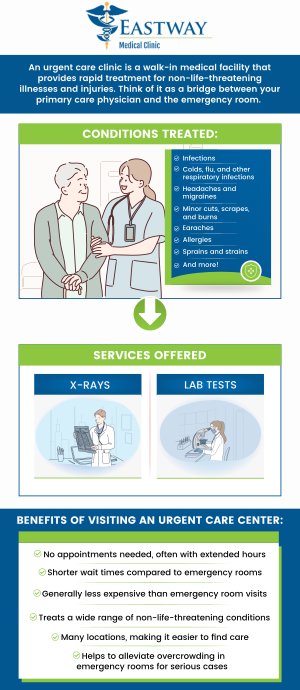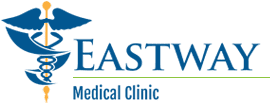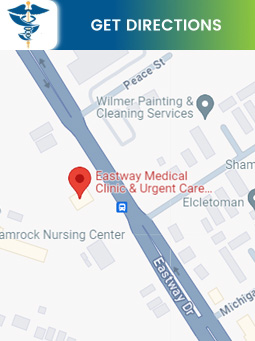Urgent Care Cost vs ER Cost in Charlotte NC
When facing sudden medical needs, it’s essential to understand the cost difference between urgent care and emergency rooms. Urgent care centers are much more affordable for non-life-threatening issues, with insured visits costing between $20 and $75, and uninsured visits ranging from $100 to $200. While ER visit can cost up to ten times more than an urgent care visit. For more information, please contact us or request an appointment online. We are conveniently located at 1220 Eastway Drive Charlotte, NC.


Table of Contents:
What is the typical cost difference between an urgent care visit and an emergency room visit for a non-life-threatening condition?
How does health insurance coverage, including co-pays, deductibles, and in-network vs. out-of-network providers, affect the cost of each?
When is it safer to go directly to the emergency room?
What types of medical conditions are appropriate for urgent care to save money, and which ones always require the more expensive ER?
Your insurance coverage. This is significantly less than the average emergency room visit for the same issues, which can range from $500 to $3,000 or more before insurance is applied. Emergency rooms are equipped for severe and life-threatening cases, leading to higher operating costs—and ultimately, higher bills for patients.
If you have insurance, your out-of-pocket expenses at our clinic are usually lower than what you’d pay at an ER. Many insurance plans offer much lower copays for urgent care visits (for example, $40 at urgent care versus $150 or more at an ER). Of course, your specific costs will depend on your insurance plan and the nature of your visit.
Health insurance coverage plays a major role in determining how much you pay for your medical care. Knowing key terms like co-pays, deductibles, and the difference between in-network and out-of-network providers can help you anticipate your costs when visiting our clinic.
Co-pays:
A co-pay is a fixed amount you pay for certain services, such as a primary care or urgent care visit, at the time you receive care. For example, your insurance plan might have a $20 co-pay for an office visit, which you pay during your appointment, and your insurance covers the remaining balance.
Deductibles:
Your deductible is the amount you need to pay out-of-pocket each year before your insurance starts to pay for certain services. If your deductible is $1,000, you will be responsible for the first $1,000 of your covered medical expenses. After you meet your deductible, you may only pay co-pays or a percentage of costs (called co-insurance) for additional services.
In-Network vs. Out-of-Network Providers:
Eastway Medical Clinic and Urgent Care is in-network with many major insurance plans. Visiting an in-network provider means we have an agreement with your insurer to charge set rates, which are usually lower for you. This helps keep your out-of-pocket expenses, like co-pays and co-insurance, more affordable. If you choose to visit an out-of-network provider, your insurance may cover less of the cost—or none at all—resulting in higher expenses.
There are certain symptoms and situations that require the specialized resources and rapid response available at a hospital ER. You should go directly to the ER if you or someone else is experiencing:
• Heart attack symptoms: Severe chest pain, shortness of breath, sweating, or pain radiating to the arm, neck, or jaw.
• Stroke symptoms: Sudden weakness or numbness on one side of the body, difficulty speaking or understanding speech, sudden confusion, vision changes, or loss of coordination.
• Serious injuries: Injuries from car accidents, significant falls, deep wounds with heavy bleeding, or possible broken bones.
• Severe allergic reactions (anaphylaxis): Swelling of the face or throat, difficulty breathing, hives, or dizziness.
• Other emergencies: Severe difficulty breathing, persistent vomiting or diarrhea leading to dehydration, sudden and severe headaches unlike any experienced before, seizures, severe abdominal pain, or any loss of consciousness.
If you are ever unsure whether your condition is life-threatening, it is always safer to err on the side of caution and go directly to the ER. For critical situations, call 911 so emergency services can provide immediate assistance.
By choosing Eastway Medical Clinic and Urgent Care for appropriate conditions, you can avoid the higher costs and longer wait times often associated with hospital emergency rooms.
Our experienced medical team is equipped to handle many urgent but non-emergency situations, including:
• Minor injuries: sprains, simple fractures, minor burns, and small cuts that may need stitches
• Common illnesses: sore throats, ear infections, urinary tract infections, rashes, and mild allergic reactions
• Respiratory symptoms: flu symptoms, coughs, mild asthma attacks, moderate fevers
• Evaluation of mild to moderate pain that is not accompanied by severe symptoms
Our clinic is designed to provide efficient care for these and similar conditions, helping you save time and money compared to an emergency room visit.
When You Should Go to the Emergency Room:
While urgent care can manage a wide array of urgent health concerns, certain symptoms and situations require immediate attention in the ER. Please call 911 or go directly to the nearest emergency room if you experience:
• Chest pain, difficulty breathing, or severe shortness of breath
• Signs of stroke: sudden weakness or numbness, facial drooping, slurred speech
• Severe abdominal pain, uncontrolled bleeding, or compound fractures (bone exposed)
• Head injuries with loss of consciousness, major trauma, or seizures
• Severe allergic reactions with difficulty breathing or swelling of the face/throat
• Any loss of consciousness or confusion
• Mental health crises or suicidal thoughts
• For infants under three months old: a fever higher than 100.4°F (38°C)
Visit Eastway Medical Clinic and Urgent Care for fast, compassionate, and expert care for all your urgent, non-life-threatening medical needs. For more information, please contact us or request an appointment online. We are conveniently located at 1220 Eastway Drive Charlotte, NC. We serve patients from Charlotte NC, Newell NC, Mint Hill NC, Matthews NC, Allen NC, Harrisburg NC, and surrounding cities.




